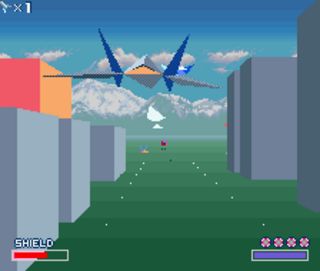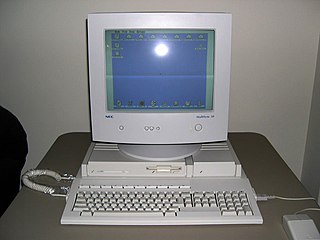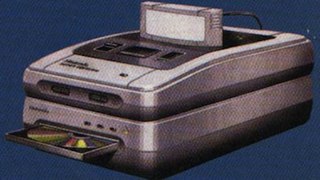The Super NES Emulator SE was a Nintendo-sponsored game development system for the Super Nintendo Entertainment System. It was designed by Intelligent Systems, and sold only to licensed Nintendo development houses.
The Super NES Emulator SE was a Nintendo-sponsored game development system for the Super Nintendo Entertainment System. It was designed by Intelligent Systems, and sold only to licensed Nintendo development houses.
The device is in the form of a large, rectangular metal box, approximately 18 inches high, and 12 inches wide, and 13 inches deep. The box is painted grey, and bears the marking "Emulator SE" on the front in grey.
The device has two controller ports at the bottom that are standard Super NES controller ports. The rear of the device featured two 50-pin SCSI interface designed to connect to a PC running MS-DOS. One of these ports came with a terminator. The rear of the device also has a port labeled "Multi-Out", which is identical to the Multi-out port on a normal Super NES control deck.
Below that, it has an 8 position DIP switch. Because there is no known copy of the documentation of this machine, the function of the switches is unknown, although it is possible the switch is used to set the SCSI ID of the device.
The units bear five-digit serial numbers.
The device is rated to consume 40 watts of power at 120 V, and bears a 1991 copyright date. It has an IEC 60320 C14 connector.
The units came in at least two and possibly more configurations with a song-compositing subsystem and a sprite-design subsystem as an option.
One configuration option adds a port labeled "MIDI" that contains a standard MIDI jack (though it's not known if the port is actually MIDI compliant), and a single RCA-Style connector in red. Investigation of the internal circuitry of the device suggests that this RCA jack is used to record sounds into the device for use in music composition.
Another configuration option adds a port called "Analog RGB", and presents a female DB-9 port. Internal circuitry again suggests that the port is an EGA port, though is probably closer in design to the ports used in Commodore 128 computer.
Inside the unit, there is a backplane board mounted to the bottom of the case, that provides six interface slots that have the same number of pins and bus design as NuBus connectors. The most complicated unit known to date has four of these slots occupied. This same board also provides the unit with an expansion connector on the bottom of the case, identical to that of the SNES.
The inside the most complex unit consists of a main logic board, which has all the components of a Super NES on it, including the SNES 65816 CPU, PPUs, and Work Ram. This board also has the SCSI controller and an NEC V20 processor, and additionally a 32k EPROM chip.
Examining the ROM chip at the Reset vector shows a JMP instruction outside the memory mapped location of the chip.
All known Emulator SE's also have a position on this board where a Standard SNES-RF Encoding Unit could be mounted, to provide an external RF port (identical to that of the Super NES) just above the "Multi-Out" port, however no known specimens have this port installed.
This board also includes a connector for a standard Super NES APU module, which is connected by wires to the next board up, which is the board which contains the MIDI and RCA connector. This audio board has many RAM chips, totaling 2 MB in size. The audio board also has many analog-to-digital converters. This board also has a 32k EPROM chip, but it is soldered to the board and could not be safely removed for investigation.
Above that board is the board that presents the RGB port. It connects only to the NuBus-style connector and has another significant amount of RAM on it.
Above that board is the cartridge board, which contains ram totaling 32 Mb worth or ram (4 MB), which was the maximum size cartridge the Super NES could support without the use of special addressing chips. These RAM chips were all socketed. The board has a separate set of 8 chips that seem to be a storage area with a battery backup, perhaps similar to the battery backed up data on a Super NES cartridge.
This board also had three empty chip slots, and one nearby populated with a Nintendo DSP1 chip.
Another Emulator SE shows this board with only 16 Mb of memory installed, and no DSP1 chip.
All of the boards bear the designation "Intelligent Systems ICE". The acronym probably means "In-Circuit Emulator."
The device was designed to be used with several software applications designed for Microsoft DOS that allowed you to program games for the Super NES, compile them, and then upload them to the Emulator SE and run the game. The PC could then monitor the status of the game, and be used for debugging.
No copy of the software to drive the Emulator SE is publicly available.
Without the software, powering the unit on illuminates the front light in red, and the unit outputs a black NTSC video signal, and an audio signal.
It is unknown how many of these units were produced. At least five units are in the hands of collectors, and the existence of an additional five is confirmed.
Square Soft had at least two of these units, and they were used in the development of the game Secret of Evermore . These two units from Square Soft are in the hands of a collector. [ citation needed ]
The Game Boy family is a line of cartridge-based handheld video game consoles developed, manufactured, released and marketed by Nintendo. It comprises three sub families: Classic Game Boy, Game Boy Color and Game Boy Advance.

The Super Nintendo Entertainment System (SNES), commonly shortened to Super NES or Super Nintendo, is a 16-bit home video game console developed by Nintendo that was released in 1990 in Japan and South Korea, 1991 in North America, 1992 in Europe and Oceania, and 1993 in South America. In Japan, the system is called the Super Famicom (SFC). In South Korea, it is known as the Super Comboy and was distributed by Hyundai Electronics. The system was released in Brazil on August 30, 1993, by Playtronic. Although each version is essentially the same, several forms of regional lockout prevent cartridges for one version from being used in other versions.

The New-Style NES is a compact cost-reduced redesigned version of the home video game console of the same name released by Nintendo in 1993.

The Atari Falcon030, released in 1992, was the final personal computer product from Atari Corporation. A high-end model of the Atari ST line, the machine is based on a Motorola 68030 CPU and a Motorola 56000 digital signal processor, a feature which distinguishes it from most other microcomputers of the era. It includes a new VIDEL programmable graphics system which greatly improves graphics capabilities.

The Super FX is a coprocessor on the Graphics Support Unit (GSU) added to select Super Nintendo Entertainment System (SNES) video game cartridges, primarily to facilitate advanced 2D and 3D graphics. The Super FX chip was designed by Argonaut Games, who also co-developed the 3D space rail shooter video game Star Fox with Nintendo to demonstrate the additional polygon rendering capabilities that the chip had introduced to the SNES.

The Atari TT030 is a member of the Atari ST family, released in 1990. It was originally intended to be a high-end Unix workstation, but Atari took two years to release a port of Unix SVR4 for the TT, which prevented the TT from ever being seriously considered in its intended market.
The Tristar 64 is an unlicensed add-on for the Nintendo 64 (N64) video game console. Produced in Hong Kong by Future Laboratory, the Tristar 64 features two additional cartridge ports which are designed to accept cartridges created for the Nintendo Entertainment System and Super Nintendo Entertainment System. The device then emulates the NES or SNES hardware, and allows the cartridge to be run. The device also features built-in cheat cartridge functionality through a program called the X-Terminator, as well as the Memory Editor, which allows SRAM and EEPROM saved game data to be archived and edited.

The Super 8, also sold under the title Tri-star or Tristar, is an unlicensed video game peripheral released in 1995 for the Super Nintendo Entertainment System designed to allow the system to run games developed for the Nintendo Entertainment System. The Super 8 utilized an NES-on-a-chip integrated circuit to duplicate the functionality of the original NES hardware, and connected to the SNES's own cartridge slot.

This article is about the various external peripherals of the Commodore 64 home computer. Due to the backwards compatibility of the Commodore 128, most peripherals will work on that system, as well. There's some compatibility with the VIC-20 and PET too.
The Apple Network Server (ANS) was a line of PowerPC-based server computers designed, manufactured and sold by Apple Computer, Inc. from February 1996 to April 1997. It was codenamed "Shiner" and originally consisted of two models, the Network Server 500/132 and the Network Server 700/150, which got a companion model, the Network Server 700/200 with a faster CPU in November 1996.

The FC Twin is a Famiclone that can play Nintendo Entertainment System and Super NES games. Manufactured by Qishenglong (奇胜隆), the system has been well-received due to the increasing scarcity of the original hardware. It is distributed by Yobo Gameware in the U.S. and Gametech in Japan.

A game cartridge, usually referred to in context simply as a cartridge, cart, or card, is a replaceable part designed to be connected to a consumer electronics device such as a home computer, video game console or, to a lesser extent, electronic musical instruments. A special type of cartridge named ROM cartridge is a memory card containing ROM. ROM cartridges can be used to load and run software such as video games or other application programs.
The list of Nintendo 64 accessories includes first party Nintendo hardware—and third party hardware, licensed and unlicensed. Nintendo's first party accessories are mainly transformative system expansions: the 64DD Internet multimedia platform, with a floppy drive, video capture and editor, game building setup, web browser, and online service; the controller plus its own expansions for storage and rumble feedback; and the RAM-boosting Expansion Pak for big improvements in graphics and gameplay. Third party accessories include the essential game developer tools built by SGI and SN Systems on Nintendo's behalf, an unlicensed SharkWire online service, and unlicensed cheaper counterparts to first party items. The Nintendo 64 video game console had a market lifespan from 1996 to 2002.

A game backup device, formerly usually called a copier and more recently a flash cartridge, is a device for backing up ROM information from a video game cartridge to a computer file called a ROM image and playing them back on the real hardware. Recently flash cartridges, especially on the Game Boy Advance and Nintendo DS platforms, only support the latter function; they cannot be used for backing up ROM data. Game backup devices also make it possible to develop homebrew software on video game systems. Game backup devices differ from modchips in that modchips are used in conjunction with systems that use generally available media such as CDs and DVDs, whereas game backup devices are used with systems that use cartridges.

The Nintendo Entertainment System (NES) is an 8-bit third-generation home video game console produced by Nintendo. Nintendo first released it in Japan as the Family Computer (FC), commonly known as the Famicom, in 1983. The NES, a redesigned version, made its debut in test markets in the United States in October 1985, before becoming widely available in the rest of North America and other countries during the following years.

The Super NES CD-ROM System, known as Super Famicom CD-ROM Adapter in Japan, is an unreleased video game peripheral for the Super Nintendo Entertainment System (SNES). The add-on built upon the functionality of the cartridge-based SNES by adding support for a CD-ROM-based format known as Super Disc.
This article describes the processor, memory, and other components of the 1996 Nintendo 64 home video game console.

The Super Nintendo Entertainment System Game Pak is the system's default ROM cartridge medium. It is called Game Pak in most Western regions, and Cassette in Japan and parts of Latin America. While the Super NES can address 128 Megabits, only 117.75 Megabits are actually available for cartridge use. A fairly normal mapping can easily address up to 95 Megabit of ROM data with 8 Megabits of battery-backed RAM. However, most available memory access controllers only support mappings of up to 32 Megabits. The largest games released contain 48 Megabits of ROM data, while the smallest games contain 2 Megabits.

The Super Nintendo Entertainment System: Super NES Classic Edition, known as the Nintendo Classic Mini: Super Nintendo Entertainment System in Europe and Australia and the Nintendo Classic Mini: Super Famicom in Japan, and also colloquially as the SNES Mini or SNES Classic, is a dedicated home video game console released by Nintendo, which emulates the Super Nintendo Entertainment System. The console, a successor to the NES Classic Edition, comes with twenty-one Super NES titles pre-installed, including the first official release of Star Fox 2. It was released in North America and Europe on September 29, 2017.